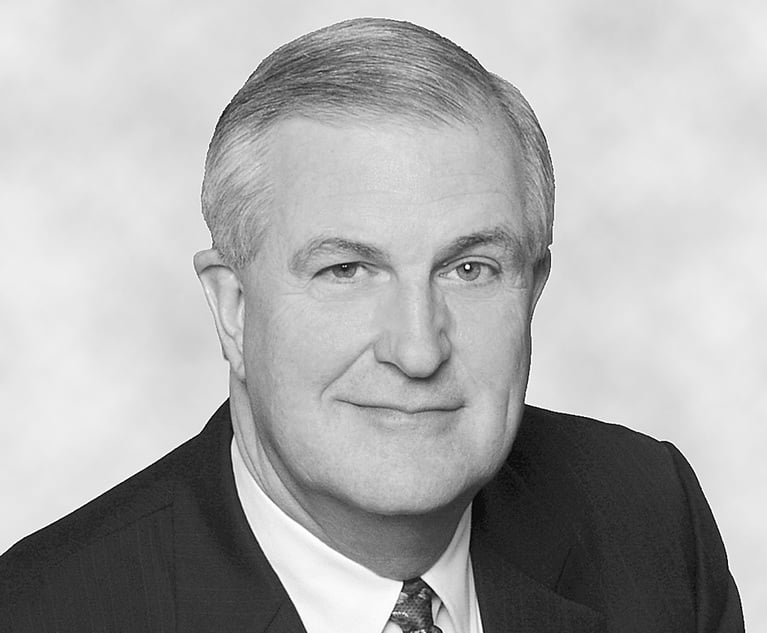U.K. Firms Looking Across the Pond Risk Entering No-Man's Land
In a sense, a tie-up with a U.S. firm offers the worst of both worlds.
March 25, 2019 at 03:00 PM
4 minute read

It doesn't take a genius to work out that there is an easier way for a law firm to operate internationally than by going through a complex merger.
Allen & Overy's protracted talks with O'Melveny & Myers are a good example of how long it can take to agree to the details of a large-scale tie-up. That is, if it happens at all. And things are rarely straightforward afterward either. One year on from its trans-Atlantic merger, Bryan Cave Leighton Paisner's management believes its 1 percent rise in revenue and 5 percent rise in profits were “great” results given the “distractions” involved.
So why not have a less formal relationship that offers many of the benefits with none of the drawbacks? The proposition sounds compelling, and more of these arrangements have emerged since the start of the year.
Taylor Wessing of the U.K. entered into an agreement to work more closely with U.S. giant Wilson Sonsini Goodrich & Rosati. The pair will work together on technology and life sciences deals and will jointly pitch to clients. U.K. firm RPC also established an alliance to act and pitch alongside U.S. firm Hinshaw & Culbertson when dealing with insurance clients.
Meanwhile, top-tier duo Slaughter and May and Cravath, Swaine & Moore, which have long had a referral relationship, have produced their first joint guidance note. It's just some basic collaboration offering advice on blockchain technology, but given that the firms involved are such traditional partnerships, it has been seen as the clearest indication yet of deepening bonds.
On the face of it, all three of these tie-ups look pretty good for the U.K. firms involved.
For a start, their reputations will benefit. Taylor Wessing may be no minnow, but it cannot boast a client base on the same level as Wilson Sonsini, which is known for advising the likes of Google, Twitter and Tesla.
The agreements could be seen as defensive maneuvers by the U.K. firms after their rivals have made progress on the other side of the Atlantic. RPC, for example, has insurance adviser rivals that include Clyde & Co, which now has nine offices in the United States, and HFW, which has agreed to mergers that give it a relatively large presence here.
The firms will also know that any referral work that comes through the arrangement is more likely to come from the U.S. to the U.K. rather than the other way around.
But that is also part of the problem with such arrangements for the U.K. firms involved. There are just 26 firms in the U.K. with revenues of more than £100 million, or $132 million, that do not have trans-Atlantic capability, according to ALM Intelligence database Legal Compass. In the U.S. there are more than 100 in the same bracket. Combine this with the fact that U.S. GDP is more than seven times the size of the U.K.'s and it is clear the direction of referrals is basically one-way—and that independent U.K. firms benefit the most.
A tie-up in an important practice area means U.K. firms are essentially limiting their supply of referrals from the world's largest legal market to just one firm. And they're not even getting the financial and marketing benefits that come with a merger. In a sense, it's the worst of both worlds.
The U.S. firms won't mind. They are getting a strong U.K. practice to help on pitches and are ensuring that they will never have their preferred relationship firm taken away by a rival on a given deal. Although U.K. firms would argue the alliances are not exclusive, the association with a specific outfit will almost certainly affect the referral work they might otherwise have received.
Firms in the U.K. may start to find themselves in an awkward no-man's land where they have neither a marriage partner nor the benefits of remaining single.
Email: [email protected]
This content has been archived. It is available through our partners, LexisNexis® and Bloomberg Law.
To view this content, please continue to their sites.
Not a Lexis Subscriber?
Subscribe Now
Not a Bloomberg Law Subscriber?
Subscribe Now
NOT FOR REPRINT
© 2025 ALM Global, LLC, All Rights Reserved. Request academic re-use from www.copyright.com. All other uses, submit a request to [email protected]. For more information visit Asset & Logo Licensing.
You Might Like
View All


Milbank, Wachtell, Ropes and Pittsburgh Duo Aim to Save Nippon Steel-U.S. Steel Merger
Trending Stories
- 1Decision of the Day: Uber Cannot Be Held Vicariously Liable for Driver's Alleged Negligent Conduct
- 2TikTok Law and TikTok Politics
- 3California Supreme Court Vacates Murder Conviction in Infant Abuse Case
- 4New York’s Proposed Legislation Restraining Transfer of Real Property
- 5Withers Hires Lawyers, Staff From LA Trusts and Estates Boutique
Who Got The Work
Michael G. Bongiorno, Andrew Scott Dulberg and Elizabeth E. Driscoll from Wilmer Cutler Pickering Hale and Dorr have stepped in to represent Symbotic Inc., an A.I.-enabled technology platform that focuses on increasing supply chain efficiency, and other defendants in a pending shareholder derivative lawsuit. The case, filed Oct. 2 in Massachusetts District Court by the Brown Law Firm on behalf of Stephen Austen, accuses certain officers and directors of misleading investors in regard to Symbotic's potential for margin growth by failing to disclose that the company was not equipped to timely deploy its systems or manage expenses through project delays. The case, assigned to U.S. District Judge Nathaniel M. Gorton, is 1:24-cv-12522, Austen v. Cohen et al.
Who Got The Work
Edmund Polubinski and Marie Killmond of Davis Polk & Wardwell have entered appearances for data platform software development company MongoDB and other defendants in a pending shareholder derivative lawsuit. The action, filed Oct. 7 in New York Southern District Court by the Brown Law Firm, accuses the company's directors and/or officers of falsely expressing confidence in the company’s restructuring of its sales incentive plan and downplaying the severity of decreases in its upfront commitments. The case is 1:24-cv-07594, Roy v. Ittycheria et al.
Who Got The Work
Amy O. Bruchs and Kurt F. Ellison of Michael Best & Friedrich have entered appearances for Epic Systems Corp. in a pending employment discrimination lawsuit. The suit was filed Sept. 7 in Wisconsin Western District Court by Levine Eisberner LLC and Siri & Glimstad on behalf of a project manager who claims that he was wrongfully terminated after applying for a religious exemption to the defendant's COVID-19 vaccine mandate. The case, assigned to U.S. Magistrate Judge Anita Marie Boor, is 3:24-cv-00630, Secker, Nathan v. Epic Systems Corporation.
Who Got The Work
David X. Sullivan, Thomas J. Finn and Gregory A. Hall from McCarter & English have entered appearances for Sunrun Installation Services in a pending civil rights lawsuit. The complaint was filed Sept. 4 in Connecticut District Court by attorney Robert M. Berke on behalf of former employee George Edward Steins, who was arrested and charged with employing an unregistered home improvement salesperson. The complaint alleges that had Sunrun informed the Connecticut Department of Consumer Protection that the plaintiff's employment had ended in 2017 and that he no longer held Sunrun's home improvement contractor license, he would not have been hit with charges, which were dismissed in May 2024. The case, assigned to U.S. District Judge Jeffrey A. Meyer, is 3:24-cv-01423, Steins v. Sunrun, Inc. et al.
Who Got The Work
Greenberg Traurig shareholder Joshua L. Raskin has entered an appearance for boohoo.com UK Ltd. in a pending patent infringement lawsuit. The suit, filed Sept. 3 in Texas Eastern District Court by Rozier Hardt McDonough on behalf of Alto Dynamics, asserts five patents related to an online shopping platform. The case, assigned to U.S. District Judge Rodney Gilstrap, is 2:24-cv-00719, Alto Dynamics, LLC v. boohoo.com UK Limited.
Featured Firms
Law Offices of Gary Martin Hays & Associates, P.C.
(470) 294-1674
Law Offices of Mark E. Salomone
(857) 444-6468
Smith & Hassler
(713) 739-1250









